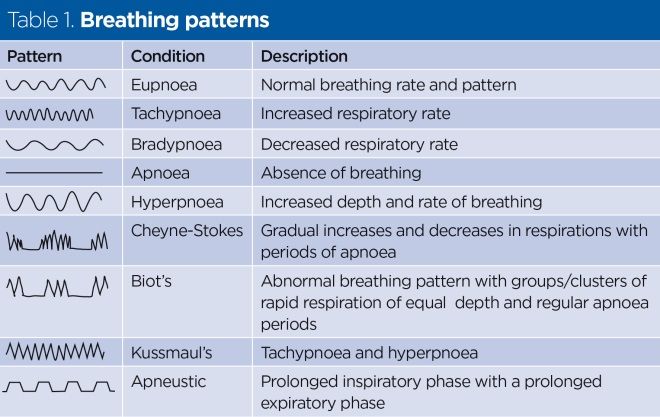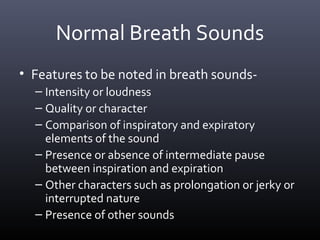Describe the Character of Normal Breath Sounds
List and describe 3 types of normal breath sounds. Breath sounds heard over the tracheobronchial tree are called bronchial breathing and breath sounds heard over the lung tissue are called vesicular breathing.

Respiratory Rate 4 Breathing Rhythm And Chest Movement Nursing Times
Study Guide for Clinical Procedures for Medical Assistants 9th Edition Edit edition Solutions for Chapter 4 Problem 16R.

. The patients diagnosis and clinical information was not available to the experts when doing this. Cavernous- It is a low-pitched bronchial breath sound classically heard over a superficial big empty cavity connected with a patent bronchus eg. Using a stethoscope the doctor may hear normal breathing sounds decreased or absent breath sounds and abnormal breath sounds.
Bronchial and vesicular. Knowing the respiratory rate would be the best measure of normal breathing. The inspiratory component predominates and is generated by turbulent airflow within the lobar and segmental.
They were categorised as A cough alone B cough. What are the types of abnormal breath sounds. Intensity is usually higher in the lower part of the lungs than at the top of the lungs.
How to describe normal lung sounds Normal breath sounds can be further divided into two subcategories. Tracheal bronchial bronchovesicular vesicular Tracheal Breath Sounds Expiration longer than inspiration with pause between inspiration expiration. Describe the differences between a systolic murmur and a diastolic murmur and how do you grade a murmur.
Vesicular breath sounds are the sounds heard during auscultation of the chest of a healthy person listen to the audio recording below. Breath sounds heard over the thorax are normally of lower intensity than tracheal sounds except in some sheep goats and camelids. A medic would likely comment on the sound of breathing by noting audible elements.
The intensity or loudness of breath sounds can be described as normal decreased diminished or absent. A nurse is assessing the lung sounds of a 6-month-old client with bronchiolitis. Breath sound have three characters.
Describe the differences between a systolic murmur and a diastolic murmur and how do you grade a murmur. Rhonchi a low-pitched breath sound crackles a. Fill in each blank with the correct answer.
Sounds heard during auscultation of the chest of a healthy person. 8 List and describe 3 types of normal breath sounds normal breath sounds from NURSING MISC at Rasmussen College Minneapolis. Frequency intensity and quality.
Amorphic- It is a low-pitched bronchial breath sound with tones and overtones or with a metallic tone. Sounds heard over the sternum. The sound is similar to whistling sound which one can produce blowing air.
However abnormal breath sounds may include. Rhonchi a low-pitched breath sound crackles a high-pitched breath sound What lung sounds are bad. Auscultation of lungs help determine the airway and alveolar integrity ventilation and presence of abnormality.
Auscultation assesses airflow through the trachea-bronchial tree. A rasp a wheeze a hiccup which might indicate an abnormality. -Bronchial - high pitch loud inspiration expiration harsh hollow tubular trachea.
They are louder and higher pitched than vesicular sounds are. Dont use plagiarized sources. Which helps us to differentiate two similar sounds.
The character of normal breath sounds is influenced by many factors including species ventilatory pattern body condition and underlying pulmonary pathology. Describe the 3 types of normal breath sounds. A squawk is a short version of a wheeze that occurs during inhalation.
Normal breath sounds vesicular sounds Inspiratory phase longer than expiratory phase without interposed gap. Normal breath sounds occur in all parts of the chest area including above the collarbones and at the bottom of the rib cage. A normal breath sound is similar to the sound of air.
It is important to auscult the trachea along with the thorax. They can be heard all over the chest and the back. The quality of these coughs sounds was assessed by experienced cough research workers by listening to the cough sounds and then confirmed by sound analysis examination of the waveforms and spectrograms.
This week describe 3 types of normal breath sounds and 2 types of adventitious breath sounds. The only place where. Absent or decreased sounds can mean.
This week describe 3 types of normal breath sounds and 2 types of adventitious breath sounds. Define what a heart murmur is when would expect to hear a murmur and when is a murmur abnormal. Name Location Description Fill in the labels indicated on the following illustration Aug 10 2021 1241 AM.
Describe the character of normal breath sounds. Anterior upper sternum in 1st and 2nd intercostals spaces. Posterior bn scapulae more on right side.
Breath sounds are described as normal when the expected sound is heard in the expected area. A normal breath sound is similar to the sound of air. Heard over areas of consolidation where sound is not filtered by alveoli.
Or they would note. Now it also sounds like you are trying to capture a sound to calm breathing and this is merely a matter of perception. Sometimes wheezing can be loud enough to hear without a stethoscope.
Place an X over the appropriate area on the illustration where it is most important. Due to transmitted air turbulence. Get Your Paper Before the Deadline.
Our Services are 100. Define what a heart murmur is when would expect to hear a murmur and when is a murmur abnormal. When lying down on one side breath sounds are usually loudest on the side of the chest closest to the exam table.
Air or fluid in or around the lungs such as pneumonia heart. Tuberous cavity lung abscess. Normal breath sounds are divided into two subcategories.
Amphoric breath sounds less common. Order Plagiarism-Free Answer. Auscultation of the lung is an important part of respiratory examination and is helps in diagnosing various respiratory disorders.
However abnormal breath sounds may include. There are two normal breath sounds. Phase1-tapping sound-systolic pressure Phase2-murmuring or swishing quality Phase3-crisper and increase in intesity Phase4-muffled and have soft blowing quality Phase5-sounds disappear-diastolic pressure.

Pt Flashcards On Twitter Pulmonaryassessment101 Auscultation Of The Lungs Includes Breath Sounds Its Character And Intensity Vocal Resonance And Adventitious Sounds Https T Co 3ttxoquydn Twitter

Lung Sounds Normal Bronchial Bronchovesicular Vesicular Breath Respiratory Sounds Youtube

No comments for "Describe the Character of Normal Breath Sounds"
Post a Comment